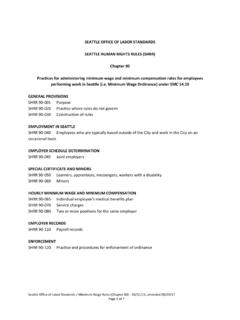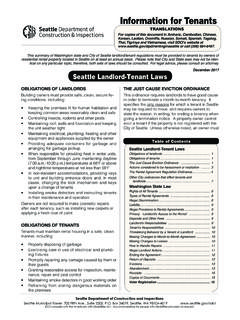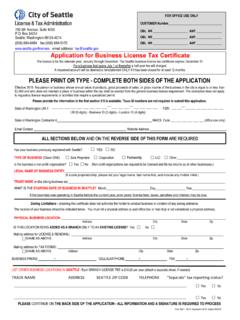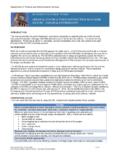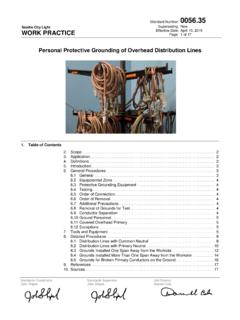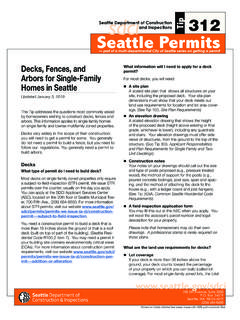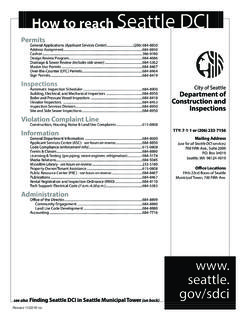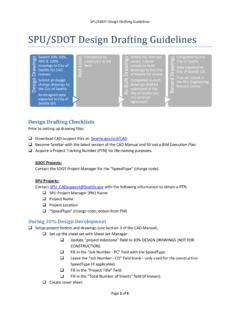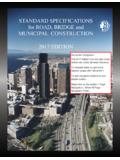Transcription of Paid Sick and Safe Time Ordinance - Seattle.gov Home
1 paid sick and safe time Ordinance Questions and Answers seattle 's paid sick and safe time (PSST) Ordinance requires employers operating in seattle to provide all employees with paid leave to care for themselves or a family member with a physical or mental health condition, medical appointment, or a critical safety issue. The seattle Office of Labor Standards (OLS) is responsible for the administration of this Ordinance , providing outreach, compliance assistance and enforcement services to workers and employers If you have a question that this Q&A does not cover, visit the Office of Labor Standards website. You may also call 206- 256-5297 or reach us electronically: Employees with questions and complaints submit an online inquiry form. Employers with requests for technical assistance send an email to or submit an on-line inquiry form. Table of Contents A. General 2. B. Interaction between seattle & Statewide paid sick Leave.
2 3. C. Employees .. 5. D. Employers .. 9. E. Accruing PSST .. 12. F. Using PSST .. 16. G. Rate of Pay & Cash-Out .. 21. H. Requesting PSST .. 23. I. Verification .. 25. J. Employer notice and posting requirements .. 27. K. Employer records .. 28. L. Prohibition on retaliation .. 29. M. Waivers .. 30. seattle Office of Labor Standards (Revised 3/31/2020, 4/8/2020, 10/28/2020). The information in this document is not intended as legal advice and should not be used as a substitue for laws and regulations. A. General information 1. What does the Ordinance do? seattle 's paid sick and safe time Ordinance , seattle Municipal Code (SMC) , establishes minimum standards for employers to provide PSST to employees who work within seattle City limits. The Ordinance also prescribes penalties, remedies and enforcement procedures. 2. (UPDATED) When did the original PSST Ordinance take effect?
3 The original PSST Ordinance took effect on September 1, 2012. The law was also amended several times since its effective date. The most recent amendments took effect on March 18, 2020, when the law was amended to expand the situations for which PSST can be used. 3. Which City department administers this Ordinance ? The City of seattle 's Office of Labor Standards (OLS) implements this Ordinance . OLS provides a range of services for employees and employers including education, training, and compliance assistance. 4. Where do employees call with questions? Can employees remain anonymous? Employees can call 206-256-5297, email or submit an online inquiry. Upon request, and to the extent permitted by law, OLS protects the identifying information ( name, job title) of employees who report violations and witnesses who provide information during investigations. OLS. will not disclose the person's identifying information during or after the investigation, to the extent permitted by law.
4 OLS may need to release names of workers who are owed payment as a result of an investigation. 5. What happens when employees call OLS? Employees may call OLS with questions or complaints. When employees call OLS, they will be directed to an intake investigator who will provide information about the law or gather information about issues at the workplace. If employees wish to make a complaint, OLS may collect information from additional witnesses and/or request documents from employees. After reviewing information provided by employees, OLS will decide if and how it can help, which may take a variety of forms, including simply providing information to the employer, trying to informally resolve the issue without a full investigation, or conducting a formal investigation. If OLS decides to investigate, and if OLS can't investigate the employer immediately, it may place the case on a waitlist.
5 6. Does an employee's immigration status impact coverage or application of the Ordinance ? No, immigration status does not impact coverage or application of the Ordinance . As a matter of policy, the City of seattle does not ask about the immigration status of anyone using City services. Read OLS'. Commitment to Immigrant and Refugee Communities for more information. 7. Can employers call OLS with their questions? Yes! OLS provides compliance assistance and training for employers. Employers can call 206-256-5297, send an email to or submit an online inquiry form. OLS does not share information about the identify of employers with our enforcement team. Phone conversations and email conversations are kept separate from the investigation process. 8. What happens when an employer calls OLS with a question about compliance? OLS encourages employers to call or email their questions to our office.
6 Our goal is help employers attain full compliance with seattle 's labor standards and we will answer many types of labor standards questions. OLS. seattle Office of Labor Standards (Revised 3/31/2020, 4/8/2020, 10/28/2020). The information in this document is not intended as legal advice and should not be used as a substitue for laws and regulations. has staff dedicated to business engagement who respond to inquiries and who are not members of the enforcement team. Phone conversations and email exchanges with the business engagement staff are kept entirely separate from the investigation process. 9. (UPDATED) What is the difference between sick time and safe time ? An employee can use sick time for the following reasons: An employee's mental or physical illness, injury, health condition, need for medical diagnosis care or treatment of a mental or physical illness, injury or health condition, or an employee's need for preventive medical care.
7 An employee's need to provide care for a family member with an illness, injury or medical appointment, etc. An employee can use safe time for the following reasons: For reasons related to domestic violence, sexual assault or stalking that affect the employee, the employee's family member or the employee's housemate. An employee's need to care for a family member whose school or place of care has been closed. An employee's place of business has been closed by order of a public official to limit exposure to an infectious agent, biological toxin or hazardous material. For businesses of 250 or more full- time equivalent employees worldwide: when their place of business has reduced operations or closed for any health or safety reason. B. Interaction between seattle & Statewide paid sick Leave 1. When did statewide requirements for paid sick leave take effect? Was the seattle law amended as a result?
8 Statewide paid sick leave requirements took effect on January 1, 2018. These requirements cover most overtime-eligible employees working in Washington state. * For more information visit the Washington State Department of Labor and Industries' paid sick Leave website. The seattle law was amended to incorporate statewide paid sick leave requirements. These amendments took effect on January 14, 2018. 2. Do employers have to comply with seattle PSST or statewide paid sick leave? Employers operating in seattle and employing overtime-eligible employees* are covered by both seattle PSST and statewide paid sick leave. By complying with seattle PSST, employers will also satisfy the requirements of statewide paid sick leave. 3. (UPDATED) What is the difference between seattle PSST and statewide paid sick leave? seattle 's PSST Ordinance and rules largely mirror statewide paid sick leave, but seattle PSST has some requirements that are more protective for employees of medium and large employers.
9 For a detailed overview of the differences, review this chart of seattle and statewide sick leave differences. Key differences between the two laws include: *. Washington State paid sick leave applies to all employees covered by the Washington Minimum Wage Act, RCW In most instances this will overlap with employees who are eligible for overtime. As a shorthand, this Q&A document uses the terms overtime-eligible and overtime-exempt to indicate employees who are covered or not covered, respectively, by the Washington Minimum Wage Act, RCW For more information about the differences between overtime eligible employees and those who are covered by the Minimum Wage Act, please visit the Washington State Labor and Industries webpage. 3. seattle Office of Labor Standards (Revised 3/31/2020, 4/8/2020, 10/28/2020). The information in this document is not intended as legal advice and should not be used as a substitue for laws and regulations.
10 Issue 2018 State 2018 seattle Employee Overtime-eligible Overtime eligible and overtime-exempt coverage employees *Error employees.*. Accrual One hour for every 40 Tier 1 & 2 1 hour per 40 hours worked hours worked Tier 3 1 hour per 30 hours worked. Carry-over 40 hours Tier 1 Employers 40 hours Tier 2 Employers 56 hours Tier 3 Employers 72 hours Tier 3 Employers with PTO 108 hours. Additionally, on March 18, 2020, the City enacted amendments to the paid sick and safe time law that expanded the situations covered by PSST. First, employees who perform work in seattle may now use their PSST for an absence caused by the closure of any family member's school or place of care. Employees no longer need this closure to be the result of an order by a public official or for a health reason. Secondly, employees of Tier 3. businesses may also take PSST if their business reduces operations or is closed for any health or safety related reason.
